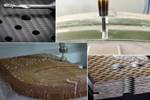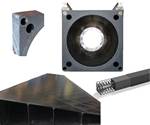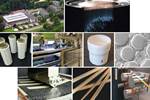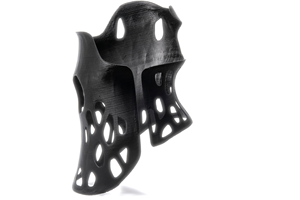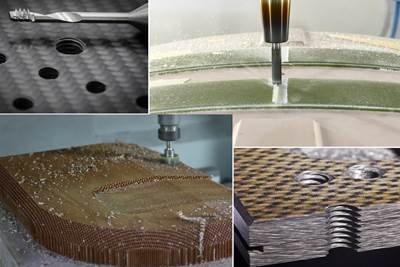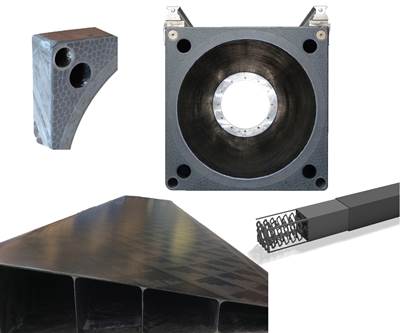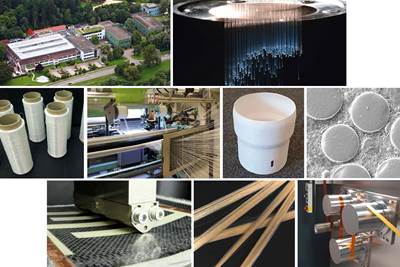Woodworking customers are demanding not only higher surface quality and precision, but also higher productivity. Lighter and stiffer tools could help meet these demands, achieving higher speeds. However, current aluminum cutting tools have exhausted their lightweight potential. The German Institutes of Textile and Fiber Research (DITF, Denkendorf) sought to address this in a federally funded joint project, working with the Institute for Machine Tools (IfW) of the University of Stuttgart. After the project, DITF and global woodworking tool producer Leitz (Oberkochen, Germany) produced and tested a prototype. The partners succeeded in demonstrating a carbon fiber-reinforced polymer (CFRP) planing head that reduced mass by 50% versus a roughly 8-kilogram aluminum tool. But instead of simply replacing the aluminum with CFRP, a totally new design was developed using computer simulation.
The modular design comprises CFRP triangular components to handle centrifugal forces and a star-shaped outer shell to address bending and torsional loads.
This virtual development resulted in a modular tool comprising CFRP triangular components that absorb centrifugal forces, and an outer shell that handles bending and torsional loads. Orienting the carbon fiber to handle the loads in these structures further aids in maximizing weight reduction, but also achieves a high stiffness and the ability to optimize eigenfrequencies — the natural frequencies at which the system vibrates. This combination improves the tool’s dynamic behavior, enabling a rotational speed 1.5 times higher than the previous tool’s limit of 12,000 rotations per minute (rpm).
First, numerical simulation was used to develop many concepts. Next, evaluation using finite element analysis (FEA) identified the best final concept. Further analysis defined forces at speeds up to 18,000 rpm, as well as stress and strain fields of each components. The stiffness of the triangles, which bear the centrifugal force during rotation, prevents a change in the outer diameter. Note, these triangles include the carriers for the rows of cutting knives. Thus, a change in the circumference or “fly circle” of the cutting edges during rotation is not allowed because it reduces the precision and surface quality of the wood during planing.
Analysis results enabled final sizing and composite layup of the CFRP components. A 200-millimeter-long triangular tube was produced using wet filament winding with HTA40 E13 6K tow carbon fiber (Teijin Carbon Europe, Wuppertal, Germany) and Epikote RIM135 epoxy (Westlake Epoxy, Houston, Texas, U.S.). The resulting 26-layer tube was oven cured for 12 hours at 84°C with an attached outer metal tool to apply pressure, achieving a constant final wall thickness of 5.5 millimeters. The tube was cut into 13 12-millimeter-wide slices.
The outer shell was made by wrapping 23 layers of dry bindered 245 gsm fabric woven (Teijin Carbon Europe) from 3K carbon fiber around a star-shaped mandrel. Vacuum-assisted resin infusion was also used with Epikote RIM135 epoxy injection resin, and the resulting laminate was oven cured under vacuum for 12 hours at 80°C to produce a 155-millimeter-long part with a wall thickness between 4.8 and 5.5 millimeters.
Leitz assembly of components for prototype CFRP planing head, including six CFRP longitudinal rods supplied by CG-Tec.
Fiber content for the triangular and star-shaped tubes was 73% and 72% by mass, respectively. Quality was confirmed using computed tomography, and the CFRP parts — including six 10-millimeter-diameter CFRP rods made by CG-Tec (Spalt, Germany) for further weight savings — were sent to Leitz for processing and assembly. The same knives, screw mounting and aluminum end clamping fixtures used in the baseline aluminum tool were included in the CFRP tool design.
The final prototype was tested in operation and monitored with high-speed cameras. No difference in quality was detected compared to the aluminum tool and all rows of knives operated homogenously. This same performance was proven in simulations up to speeds of 18,000 rpm, but testing in actual machines awaits system modifications as no metal tools currently allow such speeds.
Increased rotational speed directly increases production speed. The CFRP tool also improved dynamic behavior for high precision and surface quality. Thus, meeting increased production demands is possible with two machines instead of five. Further, a 50% lighter tool enables the use of smaller motors which require less power and energy consumption. This concept can also be applied not only to other cutting tools, but adapted for many applications where cylindrical structures rotate at high speeds (such as driveshafts) and such high mass reduction with minimized deflection and vibration could have significant benefits.
This new lightweight CFPR planer head design was recognized with the JEC World Innovation Award in 2024.
Related Content
Urban furniture project demonstrates green potential for composite 3D printing and recycled materials
Large-format AM specialist Caracol and partners designed custom, 3D-printed outdoor furniture with glass fiber-reinforced recycled polypropylene, and conducted an LCA to evaluate and improve the process.
Read MoreBio-based epoxy, recycled materials increase sustainability of all-terrain snowboards
Aiming for a smaller environmental footprint while maintaining high performance, Salomon’s Highpath snowboard line incorporates bio-based epoxy, glass and basalt fiber stringers and recycled materials.
Read MoreNanomaterials optimize performance of space-ready carbon fiber composite panels
A recent ESA project led by Adamant Composites aimed to mature nanomaterial-enhanced CFRP for lighter weight, more thermally and electrically conductive materials for manufacturing satellite structures.
Read MoreMulti-material, self-sensing, 3D-printed scoliosis braces
Startup Fited and Brightlands Materials Center have developed a lighter weight, thinner CFRP corrective brace, including pressure sensors made from continuous carbon fibers.
Read MoreRead Next
Optimizing machining for composites: Tool designs, processes and Industry 4.0 systems
Hufschmied moves beyond optimized milling and drilling tools to develop SonicShark inline quality control system and Cutting Edge World cloud platform for optimized tool use and processes.
Read MoreInnovating composites to open new markets
From machine tools to trainer jets, CompoTech develops new design and process solutions.
Read MoreDITF Denkendorf advances sustainable carbon fibers, oxide fibers for CMC and more
The German Institutes of Textile and Fiber Research are targeting more sustainable carbon fiber via low-pressure stabilization and bio-based precursors, and working with Saint-Gobain to commercialize oxide ceramic fibers for CMC.
Read More


